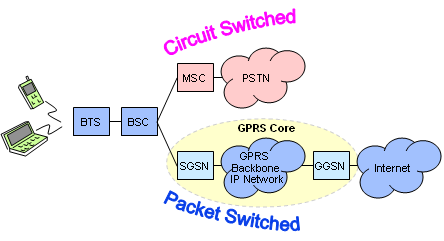
© copyright denmasbroto.com
GPRS, often called 2.5G, is a enhancement to the initial 2G network. The 2G network was a phone network and data was sent (slowly) over the phone network in a dial-up way. So either data or a phone call was possible. It was clear that a stand alone always on data network was needed. This is what GPRS supplied.
The BSC (Base Station Controller) would switch the connection between the circuit switched MSC (Mobile Switching Centre) that provided the phone services or to the SGSN (Serving GRPS Support Node) that was the packet switched data network. this, therefore, separated voice from data and would provide the first always on data service,albeit at a slow speed based on the original 2G network. Speeds of 56-171kbps were available.
There are 2 components to the GRPS network :
- SGSN (Serving GPRS Support Node) is the main component of the GPRS data network. It provides the mobile management for the data network in the same way that the MSC does for the voice network. deals with the HLR / VLR to register the phone on the network and to authenticate the use of the data network. essentially the SGSN is a big router. IP allocation is done here.
- GGSN (Gateway GPRS Support Node) provides the gateway to and from the mobile network core to the trunk IP network. it switches from the mobile network packets to the IP level packets.
When the phone makes an HTTP request this is sent to the BSC. Within the BSC the new PCU (packet Control Unit) will route the data to the SGSN. Here authentication and registration takes place. This is needs to be carried out again as this is a separate service to the user. The data is sent to the GGSN (Gateway GPRS Support Node) and from there connection to the Internet. the response reverses the route.
In GPRS a phone can be in one of 3 states :
- idleThe phone is not connected to the data network and needs to be switched to a state able to send or receive data
- active A phone must ne in an active state to send a request. The phone sends the request that is routed through the BSC to the SGSN. In this state the phone can also receive a packet. data will be routed through the mobile network to the BSC and then the aerial. This will broadcast the message to all phones connected to it. An active phone will check the IP and only read the packet if it is the correct IP. This is the same way the WiFi works.
- standbya phone in standby mode is unable to transmit, but does listen for data packets. Uses the same method as in active state, check the IP and if it is for that phone goes active and reads the packet.
Whist 2.5G is nowhere near the speed of 3G, the network core used in 2.5G is similar to that used in 3G. The mobile networks used this development as a way to test out the technology prior to the full roll out of 3G.
*u* ©mobilephonetechnology.co.uk all rights reserved 2017- 2025



